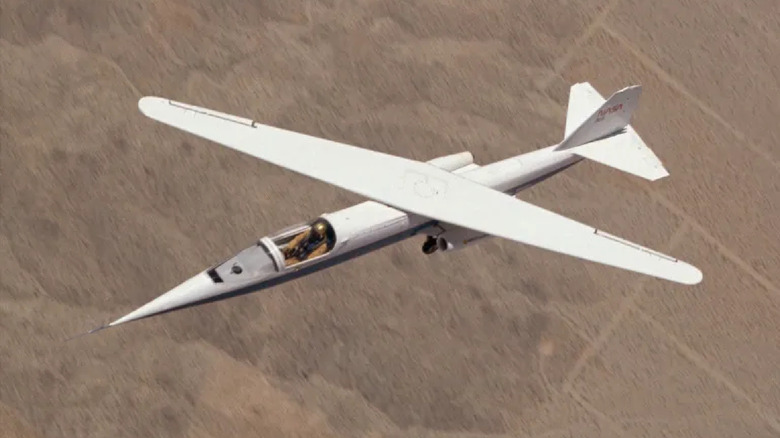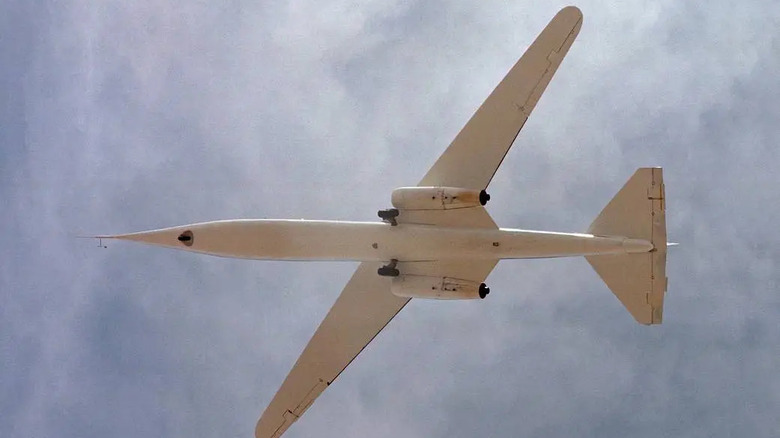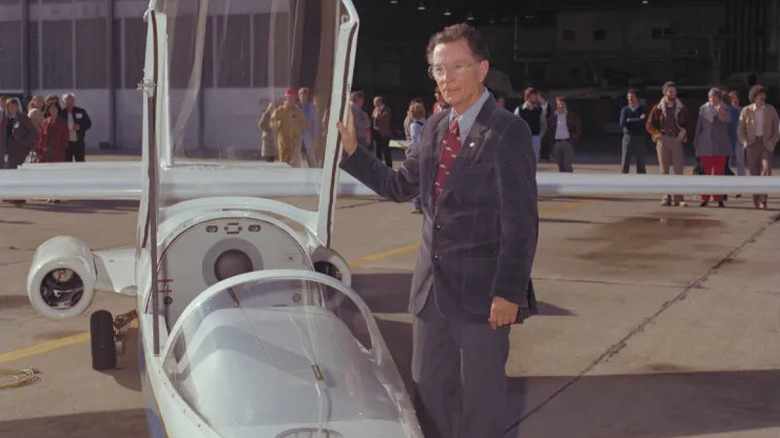These Strange Oblique Wing Aircraft Could Completely Revolutionize Air Travel
Airplanes don't need their wings to be symmetrical to take to the skies. At first, planes were designed with perpendicular wings to the plane's fuselage because every flying creature in nature suggests that's how flight works. Engineers toyed with designs throughout the years, finding that many planes function just as well with swept-back wings, such as the F-86 Sabre, which ruled the skies during the Korean War. Then engineers played with variable-sweeping wings like the ones on the F-14 Tomcat. A pilot could adjust the Tomcat's wings as they saw fit for different situations. Robert Jones, a NASA engineer, toyed with a similar idea in the '70s with the experimental AD-1, building on ideas from the German engineer Richard Vogt.
The AD-1 is a unique aircraft with a pivoting wing explored for its ability to improve fuel economy for larger planes. The idea behind it is to reduce drag at higher altitudes while planes are cruising at high speeds. Taking off and landing requires symmetrical wings, whether swept back or otherwise, but when a plane reaches higher altitudes, it can generate lift no matter the wing's orientation. It might look all wrong to the human eye, but tests proved it works fine.
So, why hasn't this design taken off? There are thoughts that aircraft designers simply weren't fans of the unpleasant flight characteristics of the AD-1. Despite having successful flight tests, creating a plane with a wing on a pivot proved challenging in the past.
These are the advantages of the oblique wing
Aircraft manufacturers weren't afraid to experiment with new ideas in the 1970s, especially with passenger planes. Take the Concorde jet, for example. It had a unique delta wing design and could fly at supersonic speeds, bringing travelers to destinations twice as fast as any other airline. Even before the crash that killed the Concorde, it was proving to be a failure of an aircraft, though.
The shape of its wings caused the Concorde to poorly operate at lower speeds and needed fuel-thirsty afterburners just to get off the ground. Traveling that fast did the Concorde no favors either as the sonic boom it produced wasn't pleasant for residents who lived in its flight path. It was a lose-lose situation for the plane. Meanwhile, aeronautical engineer Robert T. Jones believed the oblique wing design on a pivot would revolutionize air travel, especially for passenger airlines. So, tests commenced.
NASA determined that such a plane could fly faster than the speed of sound and produce only weak sonic booms that wouldn't be heard by residents on the ground. This would get around the ban on supersonic flights by civilian aircrafts. Because the wing was on a pivot, it could make adjustments to fly at a variety of speeds. Furthermore, the power requirements for take-off and landing weren't as demanding, drastically reducing the noise pollution around airports.
What happened?
By looking at the planes around any airport, you can see that oblique wings never became mainstream. The AD-1 flew a total of 79 times with promising results, but it wasn't without problems.
Stability became an issue requiring compensation from the pilot so the aircraft didn't bank to either side so much. Had the AD-1 featured modern avionics, or simply a computerized flight control system and an improved wing structure, it would have fared significantly better. As a result, the Navy showed interest in such a design in the 1980s and even supplied a supersonic jet to test the ideas on a plane that could fly faster than 200 mph.
Unfortunately, after a series of budget cuts to the Navy, the program never really got past the design phase. After 1987, testing anything like the AD-1 died in the water. Jones passed away in 1999, but he never stopped his work on the oblique wing. Christian Gelzer, chief historian at NASA's Armstrong Flight Research Center, said, "I would never say that the concept is never going to come back, but I don't see the application right now, because we've got a way around what we were trying to fix." Jones's ideas are still out there, waiting for somebody else to pick them up and bring them to fruition.


